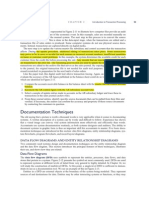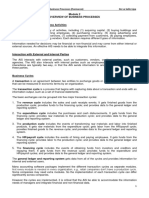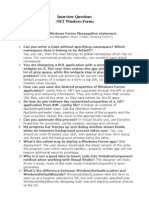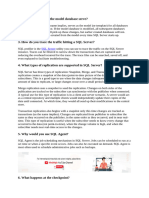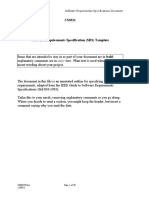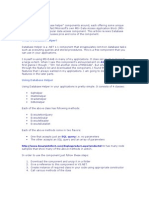Database Design Using REA Diagram
Uploaded by
Nigussie BerhanuDatabase Design Using REA Diagram
Uploaded by
Nigussie BerhanuDatabase design using REA Diagram
The role of accountant in database design
- Accountant provides information to study feasibility and they also
participate feasibility study.
- They also participate in identifying user names
- They participate in coding
- They participate in testing process
- Accountant use database system to process transaction.
Data modeling: - the process of defining database faithfully to represent all
aspect of the company.
- Entity r/ship
- REA diagram
Entity r/ship diagram: - it shows the various entities and their relationship
using graphs.
An entity relationship diagram can be expressed as rectangle to show the
relationship between sales and customers.
Sales Customers
E.g. the sales data main contain quantity of sales, price, discount, addresses,
time for carrying and the customer’s data main use Customers ID, Customers
name, Customers address, etc.
Entity r/ship diagrams can be used to document and understand existing
database and they will be used redesigned a business process.
REA Diagram: - this is another mechanism for data modeling to show the
r/ship b/n various events there are three basic types of entities in REA
diagram.
REA specifies R- Resources- this are what the organization acquires and uses.
E-Event/transaction/- in which the organization engaged.
A- Agents – this are participants
Example – in a process of selling inventory, receiving cash and adjusting cash
account balance identify the resources, events and agents.
Structuring r/ships: - the REA data modeling designs or displays a r/ship
between the resource, event and agent or (entities).
Rule no 1 – each event is linked to at least one resource it affects.
Rule no 2 – Each event linked to at least one other event.
Rule no 3 – Each event is linked to at least two agents or participants.
There are two kinds of events
1. Get event - this are events which increase the quantity of resource.
E.g. collection of cashes, purchase of inventories
2. Give event – this are events which decreases the quantity of resources.
E.g. if you purchase inventory of cashes the get event is that you
receive inventory and the give event is that you pay cash.
Can there be an event with only a get effect or give effect?
These are events which doesn’t have an increase or decrease effect they are
simply plans to purchase an inventory.
It is the r/ship between give and get events this r/ship reflects the basic
business principle that business organizations use up resources in the hope of
acquiring other resources or (transactions).
Each accounting event can be expressed in give and get economic duality. For
internal events such as transfer of raw materials production the employee who
gives up resources is an internal agent (store person) and the external agent is
the one who receive the resources.
Steps in REA diagram design
Step 1 – identify the event
Step 2 – identify the resources affected by the event and the agents participated
Step 3 – Identify cardinalities this are the nature of the r/ships b/n two entities
Step 1 – every REA model represents give and get event in transaction cycle.
The give event reduces resources and the get event increase resources.
Example- in revenue cycle there are 1. Take customer order
2. Fill customers order
3. Bill customers
4. Collect payment
Taking customers order is not a give or get event its commitment.
Filling customer is a give event b/c it reduces inventories.
Billing customers is an exchange of information it doesn’t affect resources
finally collection is get event.
Not that although account receivable is an asset in financial reporting it’s not
represented as a resource in REA model. It shows the difference b/n total sales
and cash collection.
Step 2
Identifying the resource affected which required resource reduced by the give
event and committed.
Example
In checking order selling and collection of cash the give event could be sales
the get event is cash collection. The resources reduce inventories the resource
increase at cash and taking orders in a commitment.
Also identified agents they will always one internal agent which is the employee
and mostly an external agent which is a customer or supplier.
Step 3 cardinallities – thi indicate how many instances or activities of one
entity canbe linked to a specific activities of another entities.
Examples – a company can make many sales to one customer or the company
can sale single product to many customers.
Note that there is no solid way of design cardinalities it can be customized us
needed.
Using the crow’s notation the symbol 1for zero is expressed as 0 for one 1 and
many expressed as
Note that there is usually minimum and maximum cardinality. For each entity
the minimum can be 1 and 0 the maximum can be as many as possible.
Note that the symbol for the cardinality 1 means that for every occurrence of
sales. There is one customer associated with sales.
The maximum cardinality for menu means that for every customer in the
database they can be many sales involved that is the company can make many
sales to one customers,
You might also like
- Unit 1 Cost-Volume - Profit Analysis (Cvp-Analysis) : Contribution Margin Versus Gross MarginNo ratings yetUnit 1 Cost-Volume - Profit Analysis (Cvp-Analysis) : Contribution Margin Versus Gross Margin13 pages
- WRITTEN REPORT - The REA Approach To Business Process Modeling (GROUP 10)No ratings yetWRITTEN REPORT - The REA Approach To Business Process Modeling (GROUP 10)13 pages
- THe REA Approach To Business Process Modelling (James Hall)No ratings yetTHe REA Approach To Business Process Modelling (James Hall)34 pages
- Creation of Rea Enterprise-Wide Diagram (Report)No ratings yetCreation of Rea Enterprise-Wide Diagram (Report)5 pages
- Information Technology Auditing 4th Edition Hall Solutions Manualinstant download100% (3)Information Technology Auditing 4th Edition Hall Solutions Manualinstant download51 pages
- Information Technology Auditing 4th Edition Hall Solutions Manualdownload100% (2)Information Technology Auditing 4th Edition Hall Solutions Manualdownload27 pages
- Accounting Information Systems 10th Edition Hall Solutions Manual download100% (3)Accounting Information Systems 10th Edition Hall Solutions Manual download44 pages
- Accounting Information Systems 10th Edition Hall Solutions Manual instant download100% (1)Accounting Information Systems 10th Edition Hall Solutions Manual instant download56 pages
- Free Access to Accounting Information Systems 10th Edition Hall Solutions Manual Chapter Answers100% (6)Free Access to Accounting Information Systems 10th Edition Hall Solutions Manual Chapter Answers52 pages
- Accounting Information System: Carmela L. PeducheNo ratings yetAccounting Information System: Carmela L. Peduche38 pages
- Information Technology Auditing 4th Edition Hall Solutions Manual - Latest Version With All Chapters Is Now ReadyNo ratings yetInformation Technology Auditing 4th Edition Hall Solutions Manual - Latest Version With All Chapters Is Now Ready61 pages
- Lesson 4 - Advanced Technologies in Accounting Information: I. Traditional Approaches: User-View OrientationNo ratings yetLesson 4 - Advanced Technologies in Accounting Information: I. Traditional Approaches: User-View Orientation8 pages
- Information Technology Auditing 4th Edition Hall Solutions Manualpdf download100% (1)Information Technology Auditing 4th Edition Hall Solutions Manualpdf download57 pages
- Chapter 2: Overview of Business ProcessNo ratings yetChapter 2: Overview of Business Process16 pages
- Coaching Session 2 - Basic Accounting-Accounting Equation and The Double-Entry SystemNo ratings yetCoaching Session 2 - Basic Accounting-Accounting Equation and The Double-Entry System7 pages
- Information Technology Auditing 4th Edition Hall Solutions Manual - Download Now And Never Miss A Chapter100% (3)Information Technology Auditing 4th Edition Hall Solutions Manual - Download Now And Never Miss A Chapter50 pages
- Module 1: Introduction (5 Hours) : Financial Reporting, Statements and AnalysisNo ratings yetModule 1: Introduction (5 Hours) : Financial Reporting, Statements and Analysis21 pages
- Accounting Information Systems 10th Edition Hall Solutions Manualpdf download100% (1)Accounting Information Systems 10th Edition Hall Solutions Manualpdf download45 pages
- Data Modeling and Database Design: Accounting Information SystemsNo ratings yetData Modeling and Database Design: Accounting Information Systems23 pages
- Database Design Using The REA Data ModelNo ratings yetDatabase Design Using The REA Data Model18 pages
- Chapter 2 - Summary Accounting Information Systems Chapter 2 - Summary Accounting Information SystemsNo ratings yetChapter 2 - Summary Accounting Information Systems Chapter 2 - Summary Accounting Information Systems5 pages
- Modelling Customer Retention With Rough Data ModelsNo ratings yetModelling Customer Retention With Rough Data Models10 pages
- Principles of Book Keeping.: Prof. Pallavi Vartak MMS Batch 2010-2012 Sem - INo ratings yetPrinciples of Book Keeping.: Prof. Pallavi Vartak MMS Batch 2010-2012 Sem - I35 pages
- Instant download Information Technology Auditing 4th Edition Hall Solutions Manual pdf all chapter100% (5)Instant download Information Technology Auditing 4th Edition Hall Solutions Manual pdf all chapter53 pages
- Chapter 10 The Rea Approach To Business Process Modeling67% (3)Chapter 10 The Rea Approach To Business Process Modeling13 pages
- 02 - Overview of Business Processes (Notes)No ratings yet02 - Overview of Business Processes (Notes)5 pages
- The Revenue Cycle: Accounting Information Systems, 4th. EdNo ratings yetThe Revenue Cycle: Accounting Information Systems, 4th. Ed10 pages
- Sevilla, Renz Marie A. Bsba FM 2-C: Assignment # 2No ratings yetSevilla, Renz Marie A. Bsba FM 2-C: Assignment # 24 pages
- Business Metrics and Tools; Reference for Professionals and StudentsFrom EverandBusiness Metrics and Tools; Reference for Professionals and StudentsNo ratings yet
- Summary of Peter Frampton & Mark Robilliard's The Joy of AccountingFrom EverandSummary of Peter Frampton & Mark Robilliard's The Joy of AccountingNo ratings yet
- Purchasing, Inventory, and Cash Disbursements: Common Frauds and Internal ControlsFrom EverandPurchasing, Inventory, and Cash Disbursements: Common Frauds and Internal Controls4.5/5 (3)
- CH 1 Cost Volume Profit Analysis Absorption CostingNo ratings yetCH 1 Cost Volume Profit Analysis Absorption Costing21 pages
- Interrelationship of Functional Management Information Systems100% (1)Interrelationship of Functional Management Information Systems11 pages
- 5.8.24 Audit Trail CA Narasimhan Elangovan Practical Aspects Covering Accounts Tool and Learnings 1No ratings yet5.8.24 Audit Trail CA Narasimhan Elangovan Practical Aspects Covering Accounts Tool and Learnings 149 pages
- What Purpose Does The Model Database Serve?: SQL ServerNo ratings yetWhat Purpose Does The Model Database Serve?: SQL Server10 pages
- Understanding and Selecting A Tokenization SolutionNo ratings yetUnderstanding and Selecting A Tokenization Solution33 pages
- Advantages: (Multiple Database Following Homogenous Environment Following? EachNo ratings yetAdvantages: (Multiple Database Following Homogenous Environment Following? Each10 pages
- 0000 - CO - TRN - Analyze Overhead Costs - OrdersNo ratings yet0000 - CO - TRN - Analyze Overhead Costs - Orders76 pages
- Exam 70-762: Developing SQL Databases - Skills Measured: Audience ProfileNo ratings yetExam 70-762: Developing SQL Databases - Skills Measured: Audience Profile3 pages























